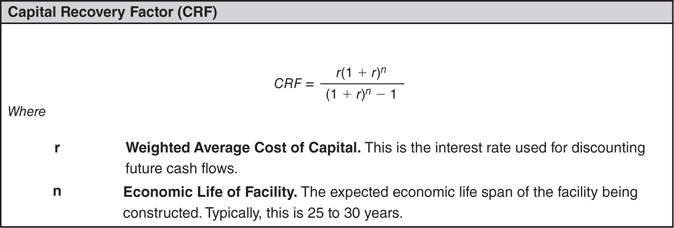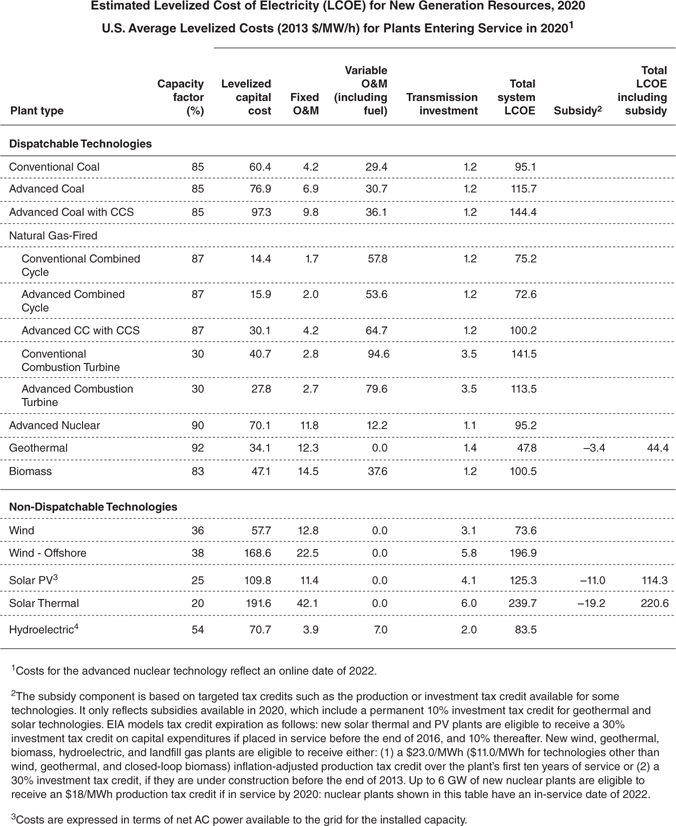4.9
LEVELIZED COST OF ENTRY
LCOE is an analysis used to predict equilibrium prices where prices will incentivize new generation. This is often referred to as fundamental analysis. When forecasting prices of a very long time horizon, examining the price where new generation will be built allows the use of a supply and demand argument to establish an upper bound on power prices. If prices rise above that point, new generation will be built and push prices lower. In periods of continuously rising consumer demand for electricity, newly constructed generation will need to be constructed and this will set power prices.
Mathematically, LCOE is calculated by dividing the cost of building a new unit over its expected life span. Then, that value is divided by the unit’s expected generation volume to find a price per unit of output. This can be expanded by incorporating the fixed and variable costs of running a unit (fuel, maintenance, operations overhead) and other real-life factors.
In addition, LCOE is a convenient way to compare the overall competiveness of different generating technologies. It represents the cost of building and operating a generating plant over a typical life span and duty cycle. Key inputs into this type of model include an estimate of the cost needed to construct new units, called the cost of new entry (or CONE). This cost is spread across the expected life of the facility using a discounted cash flow (DCF) analysis to calculate the amount of daily revenue (in units of $/MW-Day).
Mathematically, the analysis is very similar to the calculation of an annuity (a fixed income product often used as an example in finance or MBA classes). A simplified version of the calculation is shown in Figure 4.9.1. First, it is necessary to determine the return that will incentivize a builder to construct a generation unit. This can be done by calculating the weighted average cost of capital (called WACC but abbreviated as r in this example) for a typical developer (Figure 4.9.1).

Figure 4.9.1 Weighted average cost of capital
Next, the capital recovery factor (CRF) needs to be calculated (Figure 4.9.2). The CRF calculates the percent of the initial investment that needs to be earned back each year to achieve the WACC calculated in the prior step.

Figure 4.9.2 Capital recovery factor
Finally, the LCOE (per megawatt-hour of production) is calculated by incorporating fixed and variable costs. Operating expenses, maintenance, and cost to purchase fuel all increase the amount of money required each year. Additional sources of revenue, like power sales, can be subtracted from the equation to find the unmet money necessary to build a new unit (Figure 4.9.3).

Figure 4.9.3 Levelized cost of entry
It is important to note that actual investments in new generation are affected by the specific technological and regional characteristics of a project; LCOE is simply a convenient approximation of those factors. For example, the existing generation units in a region, taxes, availability of transmission, and local regulations can all affect the economics of specific projects.
Government agencies will also use LCOE-style methodologies for regulatory purposes. This can provide many of the numbers needed to do an analysis. For example, the U.S. Energy Information Agency will publish construction and maintenance costs for units as part of its Annual Energy Outlook (Figure 4.9.4).

Figure 4.9.4 U.S. average levelized costs

